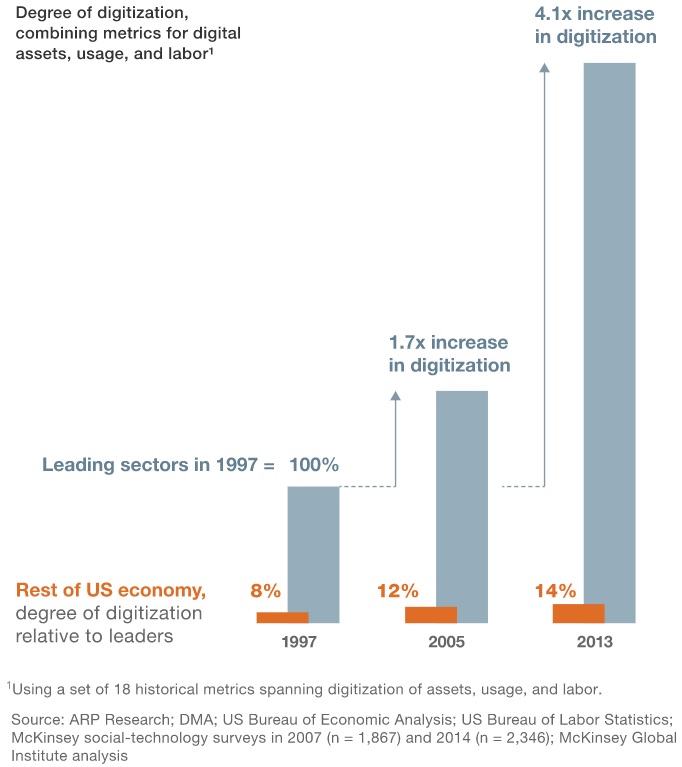The sectors, companies, and individuals on the digital frontier continue to push the boundaries of technology use - and capture disproportionate gains as a result. This growing gap between the digital "haves" and "have-mores" has profound consequences for business strategy, industry competition, the labour market and the future of work, and inequality.
Degree of digitization

The lagging sectors are less than 15 percent as digitized as the leading sectors.
- Digitization is happening unevenly, and users with advanced digital capabilities are capturing disproportionate benefits. Companies leading the charge are winning the battle for market share and profit growth.
- Digitization is not just about buying IT equipment and systems. The most explosive growth is now in usage as companies continue to integrate digital tools into an ever-widening variety of business processes.
- Digitization is proliferating new markets, breaking up value chains, and shifting profit pools. Businesses that rely too heavily on a single revenue stream or on playing an intermediary role in each market are particularly vulnerable. This vulnerability is a wake-up call and an opportunity for companies to reinvent every process.
- Digitization accelerates productivity growth. Digitization is estimated to add more than $2.2 trillion to GDP by 2025. Companies in manufacturing, energy, and other heavy industries are investing in digitizing their extensive physical assets, bringing us closer to the era of connected cars, smart buildings, and intelligent oil fields.
- Digitization increases economic dislocation, as digital technologies automate jobs day-to-day nature of work will change in a majority of occupations. As companies redefine roles and business processes, workers of all skill levels will be affected.
Digital America
A tale of the haves and have-mores
Today the race is on to capture value from data analytics and the Internet of Things, but there is no finish line. Digitization involves continuously experimenting and adapting, whether the focus is on back-office processes, the customer experience, or the introduction of new products and services. It takes investment, agility, and relentless focus to stay ahead in this hyper-competitive new world, but there are outsized opportunities for the organisations and individuals that can establish themselves as digital leaders.
Jeff Immet of McKinsey & Company explains that past companies such as airlines and industrial manufacturing would never think they would be as involved in the digital industry as they are today. Yes, airplanes use computers to assist the pilot, but now their engines have multiple sensors for heat, fuel and more, creating up to a terabyte of data in just one flight. Similar data collection is happening in the industrial trade as well.
Bottom Line
SANDSTONE has been and will continue to be, investing in digitisation. We had begun this journey at our OUTLOOK event in 2009. In 2016, we called attention to mass digitisation and its ‘no-end-in-sight' growth. In fact, when it comes to digitisation, we go beyond investment by applying these modernisations to our own business. Digitisation assists our team's research and client asset protection by expanding our investigative reach and encrypting sensitive data through layers of security.
Source: McKinsey & Company, SANDSTONE OUTLOOK 2016 Event